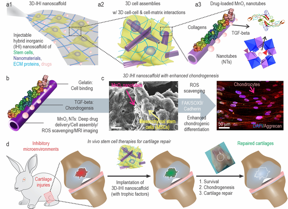Home > Press > Injectable stem cell assembly for cartilage regeneration
 |
| a) A schematic illustration of 3D TGFβ-BMSC-IHI nanoscaffold. b) The schematic illustration of gelatin-coated and TGF-β3-loaded MnO2 NTs. c) The FESEM image indicated that most of the BMSCs form contacts with other cells and the 1D fibril-like structures, which was similar to the structures of natural tissues. d) By remodeling the oxidative microenvironment, enhancing cell viability, and chondrogenesis of transplanted cells, cartilage regeneration could be finally achieved.
CREDIT ©Science China Press |
Abstract:
This study led by Prof. Qiuyu Zhang (Northwestern Polytechnical University), Prof. Ki-Bum Lee (Rutgers University), and Prof. Liang Kong (School of Stomatology, The Fourth Military Medical University). They established an injectable hybrid inorganic (IHI) nanoscaffold-templated stem cell assembly and applied it to the regeneration of critically-sized cartilage defects.
Injectable stem cell assembly for cartilage regeneration
Beijing, China | Posted on April 15th, 2022
Cartilage injuries are often devastating and most of them have no cures due to the intrinsically low regeneration capacity of cartilage tissues. The rise of 3D stem cell culture systems has led to breakthroughs in developmental biology, disease modeling, and regenerative medicine. For example, stem cells, once transplanted successfully, could initially secret trophic factors for reducing inflammation at sites of cartilage injuries and then differentiate into cartilage cells (e.g., chondrocytes) for functional restoration. Nevertheless, there are critical barriers remaining to be overcome before the therapeutic potential of stem cell therapies can be realized. The limited control over the chondrogenic differentiation of stem cells in vivo has often resulted in compromised regenerative outcomes. Moreover, due to the prevalence of oxidative stress and inflammation in the microenvironment of injury sites, stem cells frequently undergo apoptosis after injection.
To address these challenges, they demonstrated the development of a 3D IHI nanoscaffold-templated stem cell assembly system for advanced 3D stem cell culture and implantation. 3D-IHI nanoscaffold rapidly assembles stem cells into injectable tissue constructs through tailored 3D cell-cell and cell-matrix interactions, deeply and homogeneously delivers chondrogenic proteins in the assembled 3D culture systems, and controllably induces chondrogenesis through nanotopographical effects. Once implanted in vivo in a rabbit cartilage injury model, 3D-IHI nanoscaffold effectively modulates dynamic microenvironment after cartilage injury through the integration of the aforementioned regenerative cues, and simultaneously scavenges reactive oxygen species using a manganese dioxide-based composition. In this way, accelerated repair of cartilage defects with rapid tissue reconstruction and functional recovery is realized both in the short term and long term. Given the excellent versatility and therapeutic outcome of 3D-IHI nanoscaffold-based cartilage regeneration, it may provide promising means to advance a variety of tissue engineering applications. The first authors are Dr. Shenqiang Wang, Dr. Letao Yang, and Prof. Bolei Cai.
####
For more information, please click here
Contacts:
Bei Yan
Science China Press
Office: 86-10-64015905
Expert Contact
Prof. Qiuyu Zhang
School of Chemistry and Chemical Engineering, Northwestern Polytechnical University
Copyright © Science China Press
If you have a comment, please Contact us.
Issuers of news releases, not 7th Wave, Inc. or Nanotechnology Now, are solely responsible for the accuracy of the content.
News and information
![]()
Scientists develop indoor-active photocatalyst for antiviral coating against various variant types of novel coronavirus SARS-CoV-2 April 15th, 2022
![]()
Flexible quantum sieve made at TU Dresden filters the fuel of Starship Enterprise April 15th, 2022
![]()
Photocatalysts with built-in electric field helps to remove pollutants from water April 15th, 2022
Possible Futures
![]()
Scientists develop indoor-active photocatalyst for antiviral coating against various variant types of novel coronavirus SARS-CoV-2 April 15th, 2022
![]()
Flexible quantum sieve made at TU Dresden filters the fuel of Starship Enterprise April 15th, 2022
![]()
Photocatalysts with built-in electric field helps to remove pollutants from water April 15th, 2022
Nanomedicine
![]()
Delivery systems of plasmid DNA and messenger RNA for advanced therapies April 15th, 2022
![]()
Scientists develop indoor-active photocatalyst for antiviral coating against various variant types of novel coronavirus SARS-CoV-2 April 15th, 2022
![]()
Nanomedicine for brain cancer April 8th, 2022
![]()
Nano therapy for micro-preemies protects lungs, brain in lab study April 1st, 2022
Discoveries
![]()
Delivery systems of plasmid DNA and messenger RNA for advanced therapies April 15th, 2022
![]()
Achieving higher performance with potassium ion battery April 15th, 2022
Announcements
![]()
Scientists develop indoor-active photocatalyst for antiviral coating against various variant types of novel coronavirus SARS-CoV-2 April 15th, 2022
![]()
Flexible quantum sieve made at TU Dresden filters the fuel of Starship Enterprise April 15th, 2022
![]()
Photocatalysts with built-in electric field helps to remove pollutants from water April 15th, 2022
Interviews/Book Reviews/Essays/Reports/Podcasts/Journals/White papers/Posters
![]()
Scientists develop indoor-active photocatalyst for antiviral coating against various variant types of novel coronavirus SARS-CoV-2 April 15th, 2022
![]()
Flexible quantum sieve made at TU Dresden filters the fuel of Starship Enterprise April 15th, 2022
![]()
Photocatalysts with built-in electric field helps to remove pollutants from water April 15th, 2022
Nanobiotechnology
![]()
Delivery systems of plasmid DNA and messenger RNA for advanced therapies April 15th, 2022
![]()
Scientists develop indoor-active photocatalyst for antiviral coating against various variant types of novel coronavirus SARS-CoV-2 April 15th, 2022
![]()
Nanomedicine for brain cancer April 8th, 2022
![]()
Nano therapy for micro-preemies protects lungs, brain in lab study April 1st, 2022










